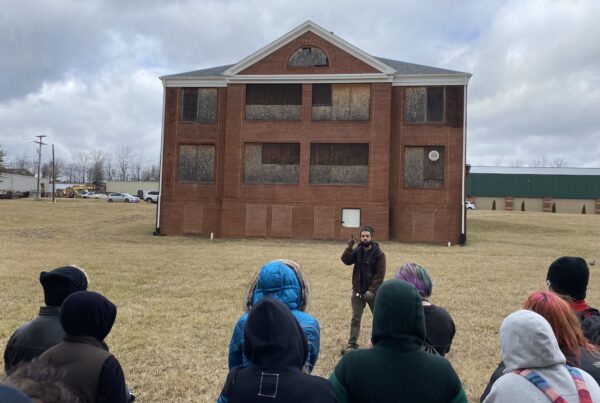by Ian Stabler
In the first trimester, a group of students learned with me about pollinators as part of our elective Creating and Enhancing Pollinator Habitat at Springhouse. This course was born as part of our continued efforts towards a fully functional and sustainable agriculture program at Springhouse. Our hope is to not only use the garden as a place to learn about growing and caring for our plants and Earth, but to also provide food and medicine to our community. As part of this dream, we are planning on bringing honeybee hives to our campus to help pollinate our crops and bring these essential workers into our ecosystem. This class seeks to study and provide support to the ecosystem these bees will inhabit.
As many of you know, our campus was once the home to the Blue Ridge Center for Chinese Medicine. During it’s time as this healing center, the dedicated and versatile staff created a series of cascading terraced garden beds, multiple greenhouses, and in general, an ideal habitat for native and introduced pollinators (like the honeybee!). Since BRCCM left the property and our arrival and inability to more fully engage with the gardens, much of the garden space that was so beautifully maintained has been swallowed into the grass and growth. Our goal as a class is both to document and inventory the pollinator species we have on campus, and to work towards creating more habitat for native and honey bee pollinators.
Our approach has been twofold:
Our first priority has been to learn as much about these species and their unique relationship to the plant realm as possible. Fortunately for us, we have had the joy and wonder to partner with our friends at Spikenard Honeybee Sanctuary. Frankly, the level of expertise, care and knowledge from them has been astounding. They are truly an example of what can happen when a vision and mission are held at the center of an organization and we are so grateful for their help and inspiration. So, some nuggets we learned to help inspire you:
- One native leaf cutter bee can do the pollination job of 20 non-native bees. This is largely due to the highly specific relationship between some insects and plants that have evolved together.
- Stinging insects are the only producers of formic acid in the world. This acid is essential for creating proteins that make up our bodies.
- Not only do pollinators pollinate plants by spreading their pollen, they also breathe out this formic acid into the plants. The plants then use this acid to create proteins and grow more, allowing them to create more flowers for the pollinators to feed on and pollinate!

Our second priority is to create more habitat for pollinators on Springhouse’s campus. This is partly in preparation for the honeybees we hope to introduce, but also to support the many native pollinators that are already present. We can do this by planting beneficial plants, and making sure our campus has early blooming flowers, flowers that bloom throughout the summer, and some that bloom through the fall. We are also planning on building a “pollinator hotel”. These structures create habitat for solitary bees and wasps, like mud daubers and leaf cutter wasps primarily by providing holes for nests. These species work alone to collect individual pollen balls for each of their eggs. They then deposit these into holes they have carved or found and seal them up until the spring.
One of the great joys about teaching at Springhouse is being able to engage in this sort of learning myself. My life as an adult rarely necessitates knowledge about pollinators or their habitat, and my time becomes increasingly sparse as my life flows on. To be able to follow curiosity and joy when I am teaching is such a gift to that piece of me that needs wonder. When we then couple this wonder with a real need for our community and the world, the learning holds both the power of wonder and emergence, as well as the gravity and structure of service and meeting the world’s need. This is a powerful place to be, and I am grateful for it.



